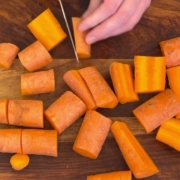How to Make The Ultimate Sous Vide Prime Rib with Mint Persillade
For more great Instant Pot recipes, please visit InstantPotEasy.com
Hosts Bridget Lancaster and Julia Collin Davison make the ultimate Sous Vide Prime Rib with Mint Persillade. Get our Sous Vide …









Thanks – I needed the extra details, including the 16-24 hours. Prime roast can be tough even when medium rare and I find that very disappointing. Most others are saying 6 to 10 hours and that seemed quick to me.
This method takes way too long two days?!?!!! Plus the sous vide machine is too expensive this recipe is for rich people!! 😢
Interesting information and some ideas. I'll probably stick with my smoked prime rib roast. Just don't see how this would have much flavor.
The loin end selection is a personal preference. I prefer the chuck end because it has a bigger cap or Spinellis which to me is much better. Keep in mind this primal originally has seven bones so usually you are ordering a half cut prime rib. You will either get four or three bones depending on how they cut it
For those who don't have the equipment for sous vide, a tried and true method for the perfect looking as well as super tender medium rare prime rib is simple: Brown the outside of the roast in a hot skillet, then place in a roasting pan; cover and roast in the oven at 200 degrees. Remove from the oven when the internal temp at the center of the roast reaches about 127 degrees. Loosely cover with some foil and let it rest for around 20 minutes. By then the internal temp should rise to about 132-133 degrees, which is the perfect medium rare temp. Obviously, if you like your roast more rare or more cooked, adjust the internal temp accordingly. This procedure takes a little longer due to the really low temp, but it's well worth it.
how do you estimate time for a large rib roast, in the range of 10 pounds? I can find charts showing cooking temps but not how long to cook them. doesn't look like I can stick a temp probe into the meat and cook to the desired 130° F
Another Great Job, Thanks You
You don't need a sous vide machine. This is too complicated. All you need is a meat thermometer with a probe.
Steps:
1. Season the roast with salt & pepper. Put it on a roasting rack.
2. Set your oven temp to 250 degrees F.. No need to preheat the oven.
3. Stick your meat thermometer probe into the center of the meat.
4. Set the alarm to go off when the internal temp reaches 118 degrees F.. Cook the meat.
5. Take the meat out of the oven and let it rest for about 30 minutes.
6. Raise the oven temp to 500 degrees F.
7. Put the meat back into the oven for about 10 mins. This should bring up the internal temp to around 125-130 degrees F.
8. Take the meat out of the oven. Cut and serve. There is no need to rest the meat.
I have found using a metal straw is also good at sucking air out as well. at the stage before going into the water and then again sucking the last bit of air that works its way to the top out as well. I haven't made this dish though btw
Really enjoying cooking Sous Vide. What size bone in prime rib was that? How many people would that feed? Is there a maximum size limit? Would two smaller cuts be better?
As the new owner of a sous vide device I watched this with interest. I understand how this might be of benefit for say a chuck roast to hold it for a long time to "tenderize" it but I am puzzled over treating a prime rib this way…appears to be a complicated process for a roast that is already relatively tender. Seems to me after doing the fridge brining, cooking in the oven would be a whole lot easier…? Also, since you will be broiling at the end, was the initial browning really necessary? Serious questions, not trying to be a troll I promise.
I thought you want near the chuck… I'm a chuck kind of guy.
I watched this whole video even though I knew I’d never cook this 😆
Curious about the bone selection. This is one of the only videos I’ve ever seen not recommending to buy from the chuck end and preferring the eye to the cap.
hello
wheres the yorkshire pudding
Thank you for the prime rib buying and preping tips and recipe. I didn't realize how long the cooking time would take. It leaves so much free time to prepare appetizers, sides, salads, breads, rolls, and desserts. And, it frees up the oven for other dishes. Wonderful!
We are a gravy and mashed potato family. The juices from the roast look spectacular for a silky gravy.
Thanks again!
This recipe is supposed to be in the new cookbook but I can’t find it. Can anyone help please?
I worked 29 years as a chef, 6 of those on a restaurant where we cook prime rib every day, but I never saw this way of cooking prime rib, it looks good but inconvenient, lots of people like it rare and keeping it for so many hours would be hard 🙁 . home cooking for the holydays, maybe, but I don't think I would be able to hold this long, smelling prime rib all over the house for few days will be hard🙂.. 🙂
I imagine everything I dislike about Prime Rib would only be magnified if it was sous vide. In my opinion beef should always be eaten raw or cooked fast at a high temperature. The only possible exception is BBQ, but I rarely order Brisket if given a choice. Beef Ribs are really good though.
It is just too pink for me.😕
Did she say you want a really big meat muscle??
Has anyone actually tried this recipe? They always say the food is delicious, even when it's just a so-so recipe. Any feedback is great. Thanks
Lol they have it ALL backwards! 🤣
1. Sous vide first (tenderize and render).
2. Dry brine (impart flavor, salt, and crust).
3. Brown, crust, roast.
4. 😂😆🙄🙄🙄 lol "prime rib 4-8 minutes under the broiler.???" Are you kidding me?
Flawless cut shot, wow! Will definitely try the pesillade next time. I’m still sold on using the egg for it- love the smoky tones too much not to!
just because it's a "new" fangle method doesn't makes it "good" or "great". IF…IF…you know what the "HECK" you are doing…you'll make an "INCREDIBLE" RIB ROAST.
SAVE your money and use the kitchen tools you already have, and follow BASIC cooking techniques (COOKING SKILLS), and the application of COMMON SENSE AND YOU'LL END UP WITH A PHENOMENAL ROAST.
TRY IT.
Any make-ahead tips?
I'll be doing the sous-vide part at home, then driving for an hour-ish, partying a little, then throwing under the broiler.
That looks amazing! I've ordered my sous vide, only question, what are the measurements of a 2 gallon bag please?
You're cooking with an immersion circulator, not "a sous vide". Sous vide is a method or process, literally meaning "under vacuum", and the immersion circulator is the tool with which you cook sous vide. 😊
I do this every year and it makes a phenomenal cant miss dinner.
In my experience zip-lock bags become semi-permeable during longer cook times. It can be difficult to find a bag big enough for a larger prime rib. I found that Cabelas sells larger bags for processing wild game and they are perfect for this application as I am a bone-in person The ribs are divine BTW.
We sear ours after sous vide and right before serving. I have a rack that drops into a large cast iron pan. That goes onto a small lazy Susan and out comes the torch. It is a crowd favorite!
Keep-it-simple version: trim the fat, skip the salted “marinade," put the meat in the bag, check Internet recipes for cooking times/temperatures for the doneness you want. Let cool until you can pour the juices out of the top of the bag (use the bag again later!). Save the juices for whatever: gravy, au jus,etc. Sear (stovetop or oven) if that’s how you do prime rib. Some people say to put the bagged meat in the freezer for ten minutes before searing as searing hot meat will cook it more.
Been using the hot tub time machine for 5 years. Have never ruined prime rib since! Works great with store brand sprial hams that are vacuum sealed. Also great for perfect soft boiled eggs, vegetables too. Purchased vacuum sealer to break down full ribs when on sale too. Works well when starting or finishing with sear or smoke!
I’m trying to use the Sue’s vied method but keep seeing Recipes like this not compleat no sauce, no gravy, not using drippings for anything your teaching people at least in my cast that this is, A NEW METHOD OF COOKING please exaggerate just a bit as to what to do with the rest. HELP!
We’re is the gravy? How do you make a roast like this & there’s no sauce?
Is resting really important when you are using sous vide??? It's my impression that it is not.
Oh man! Boiling my prime rib in microplastics? Wow sounds delicious.
hey ….ATK…do yall think most if any home users have a 2 gallon ziploc bag?!?! lets be real here…stop making content just to make content. be PRACTICAL! just give us the reverse sear…upgrade, more tips and tricks, solutions…
…yet another WINNER WINNER!
Zip lock bags are notorious for leaking! You will ruin your very expensive roast. I would definitely make this recipe with a vacuum sealed bag.
What a great demo, thank you! I'm hoping this step up maybe also means that ATK is getting ready to start publishing measurements by weight in grams? A kitchen scale is a much smaller investment than an immersion circulator and gram measurements are so much more accurate for baking.
Seems a good way to get BPA into your food and body…
I normally kind of dread Christmas… After watching this it cannot get here soon enough.
dry aging the roast is key. It is amazing how much more intense flavor you get by dry aging the prime rib roast in the fridge for 2-3 days. I drilled holes in a plastic tub and put a small battery-operated fan to circulate the air which helps it dry.
I have never sous my roast as I always had great results cooking it on the bbq rotisserie. the trick it to have the bone side facing the heat for 20-30 minutes before turning on the rotisserie. heating the bones helps ensure the roast gets a more even cook.
What is the purpose of removing the ribs? Seems wasteful.
That prime rib looks amazing.
This was a fantastic video here is a link to another video of how to do a prime rib if you don't happen to have a sous vide. This is from Chef John on Food Wishes. https://www.youtube.com/watch?v=NUQ49SoteE0
That was a lot of work, but I bet it was worth it!